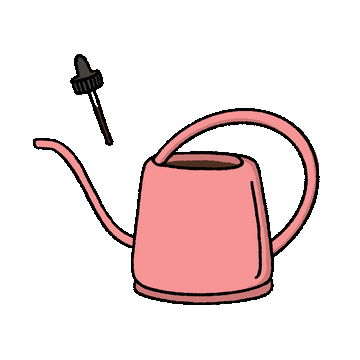Potting Mix Guide
When you bring home a new plant, it’s tempting to focus on its foliage or flowers, but the secret to helping it thrive often lies beneath the surface—in the potting mix you choose. While the plant may arrive in basic nursery media, investing in the right potting mix is essential for its long-term health.
Why Soil and Potting Mix Matter
The Role of Soil in Nature
Healthy soil is the foundation for plant growth and plays a crucial role in ecosystems. It not only supports roots but also retains water, provides essential nutrients, and fosters beneficial microorganisms. Soil acts as a living environment that sustains plants, animals, and even humans by influencing the quality of the food we eat. However, not all soil is created equal. Different plants have unique needs based on their natural habitats. For instance, succulents thrive in arid deserts with sandy, well-draining soil, while tropical plants like Monsteras require nutrient-rich, moisture-retaining soil to mimic the conditions of rainforests. Understanding these differences is key to helping plants thrive.
What About Nursery Mix?
Most plants from nurseries are grown in affordable, grower-specific media such as sphagnum moss, coir, or lightweight seed-raising mix. These growing mediums are optimized for propagation and quick growth in controlled environments but are not intended to support a plant’s long-term health or development. Over time, these mixes can become compacted, hold too much water, or fail to provide sufficient nutrients. Replacing this temporary nursery media with a high-quality potting mix tailored to your plant’s needs is essential. The right potting mix encourages strong root systems, lush foliage, healthy blooms, and consistent growth, ensuring your plant can thrive well beyond its nursery beginnings.
Soil vs. Potting Mix
What’s the Difference?
- Soil is a natural substance found outdoors and is made up of a mix of dirt, organic matter, minerals, and microorganisms. It forms over time through the breakdown of rocks and the decomposition of organic materials like leaves and plants. While it’s rich in nutrients, outdoor soil can vary greatly in quality and often contains pests, pathogens, and weed seeds.
- Potting Mix is a soil-free medium specifically designed for potted plants. It’s made from a blend of materials like composted bark, perlite, sand, coir, and sometimes peat moss. These components are carefully selected to make it lightweight, well-draining, and free of harmful pests or pathogens commonly found in outdoor soil. Unlike garden soil, potting mix can provide consistent moisture retention and aeration, which are essential for healthy root growth in containers.
Why Not Use Garden Soil Indoors?
Using outdoor soil for indoor plants might seem like an easy option, but it often creates more problems than solutions. Garden soil tends to compact when used in pots, leading to poor drainage and suffocating plant roots. Additionally, it may introduce pests, weed seeds, and diseases into your home, which can quickly spread to other plants. Potting mix, on the other hand, is specifically formulated for indoor use. It provides the right balance of aeration, moisture retention, and nutrients while ensuring your plants stay healthy and pest-free. Investing in quality potting mix helps your indoor plants thrive and saves time and effort in the long run.
When to Repot or Pot Up
Annual repotting is an essential step in keeping your plants healthy and thriving. It refreshes the potting mix, providing your plant with a fresh supply of nutrients and extra space for root growth, which is vital for its overall health. When it’s time to repot, you have two main options:
- Repot: Replace the old potting mix with fresh, nutrient-rich soil while keeping the plant in the same pot. This is ideal if the pot is still appropriately sized for the plant but the soil has become compacted, depleted of nutrients, or is no longer providing proper drainage. Repotting can revitalize the plant by ensuring it has access to fresh nutrients and better aeration while maintaining its current container.
- Pot Up: Move the plant into a slightly larger pot (no more than 1-2 inches wider in diameter) and fill it with fresh potting mix. This option not only refreshes the soil but also gives the roots extra room to grow, which is especially important for plants showing signs of being root-bound. Potting up allows your plant to expand its root system, leading to healthier growth and better overall stability.
Signs It’s Time to Repot or Pot Up
- Roots Are Visible: If you notice roots growing out of the drainage holes at the bottom of the pot or tightly circling the inside (when you take the plant out of the pot), these are signs the plant is root-bound. A root-bound plant doesn’t have enough space to grow and may struggle to absorb water and nutrients, making repotting or potting up essential for its health.
- Stunted Growth: If your plant is well cared for—getting enough sunlight, water, and fertilizer—but still isn’t showing signs of new growth, it could be because the roots are overgrown and lack space to expand. This can limit the plant’s ability to thrive and is a clear indicator that repotting or potting up is needed.
- Rapidly Drying Media: When the soil dries out much faster than it used to, it’s often a sign that the roots have become overcrowded, leaving little room for the potting mix to hold moisture. This can lead to frequent watering and potential stress for the plant, signaling it’s time for a new pot or fresh soil.
- Plant-to-Pot Ratio Looks Off: If your plant is visibly too large for its pot, appearing top-heavy, or out of proportion with its container, it’s struggling to support itself in the limited space. A larger pot will provide a more stable base and allow the plant to continue growing without becoming unstable or stressed. A good rule of thumb is to pot up when the plant looks like it’s outgrowing its home.
Repotting or potting up might seem like a small task, but it can make a big difference in your plant’s health. Whether you’re giving the roots more breathing room or simply refreshing the soil, these steps help ensure your plant gets the nutrients and space it needs to stay healthy and beautiful.
Types of Potting Mix
Choosing the right mix can make all the difference. Here’s a breakdown of the most popular types.
Aroid Mix
Designed specifically for tropical plants, this mix blends large orchid bark, perlite, coco peat, and nutrient-rich compost to create the perfect growing environment. The chunky texture allows bigger roots to grow freely, while retaining just the right amount of moisture for healthy plant development. Its aerated composition prevents waterlogging, ensuring your tropical plants thrive in optimal conditions.
Ideal for: Monsteras, Philodendrons, Syngoniums, Anthuriums, and other Araceae plants, providing them with the support they need to grow lush and vibrant.
Indoor Mix
A versatile, all-purpose potting mix perfect for a wide range of indoor potted plants. It includes composted bark, perlite, scoria, coco coir, and slow-release fertiliser to provide balanced nutrition over time. This mix is lightweight yet retains enough moisture to keep plants hydrated, while its aerated structure promotes strong root growth. Whether you’re maintaining your collection of leafy houseplants or adding new varieties, this mix ensures your plants stay healthy and thriving.
Great for: Ficus, African Violets, Caladiums, Fittonias, Palms, and many other popular indoor plants.
Cacti and Succulent Mix
Specially formulated for cacti and succulents, this mix is designed for fast drainage and minimal water retention, using a combination of sand, scoria, and composted bark. It mimics the dry, arid conditions that these plants naturally thrive in, preventing root rot and ensuring they stay healthy. The gritty texture also provides excellent support for the shallow root systems typical of cacti and succulents, helping them grow strong and stable.
Best for: All cacti and succulents, from towering desert cacti to tiny rosette succulents, giving them the ideal foundation for growth.
How to Repot Your Plants
Repotting might seem daunting, but it’s a straightforward process when broken into manageable steps.
Before You Start:
- Set Up Your Workspace: Lay down a tarp or sheet to catch any mess.
- Have Tools On Hand: Ensure everything is within reach to avoid interruptions.
- Pick the Right Pot: Use a pot only 1–2 sizes larger than the current one.
- Prepare Your Potting Mix: Choose the mix best suited for your plant.
Step-by-Step Guide:
- Loosen the Plant: Gently squeeze plastic pots or use a knife around the edges of ceramic pots to free the plant.
- Remove the Plant: Turn the pot upside down and carefully slide the plant out, supporting the soil and roots with your hand.
- Tease the Roots: Gently loosen the outer roots to encourage outward growth in the new pot.
- Prepare the New Pot: Place a piece of landscaping fabric over the drainage holes to prevent leaks.
- Add Potting Mix: Layer mix at the base so the plant sits just below the pot’s rim. Firmly press the mix as you fill around the plant to remove air pockets.
- Water Thoroughly: After repotting, water the plant well to minimise transplant shock.
Supporting Your Plant’s Growth
By using the right potting mix and repotting regularly, you’re giving your plant the best chance to grow strong and healthy. The right soil provides essential nutrients and proper drainage, while regular repotting prevents root-bound issues and promotes new growth. Simply follow these steps, adjust as needed for your plant’s specific requirements, and enjoy watching it flourish in its new environment. Remember, every plant has unique needs, so take the time to understand what works best for yours.
For premium potting mixes tailored to your plant’s specific needs, explore our carefully curated range today. With the right care and materials, you’ll have a thriving green companion in no time. Happy planting!


